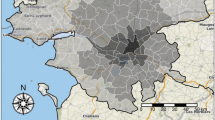Abstract
Taiwan does not only have a high population density; its population exhibits a strong preference for high-density downtown living. Rich Taiwanese thus live downtown, not in the suburbs. In addition, the expected negative relationship between accessibility and the spaciousness of housing is weak or non-existent in Taiwan’s metropolitan areas. Taiwan should therefore be highly suited to rail transportation investments. In 2007, a new high-speed railroad was inaugurated, connecting seven metropolitan areas. Hedonic estimates show that high-speed rail accessibility has a substantial impact on house prices in at least four of the regions. Interregional downtown-to-downtown commuting time seems to be the most important determinant of success in generating a station-centered price-distance gradient. Neighborhoods around HSR stations in suburban locations are not likely to spawn residential communities for commuters, since most Taiwanese prefer downtown residential locations.
Similar content being viewed by others
References
Andersson DE, Andersson ÅE (2008) Requirements for the region’s economic development. In: National atlas of Sweden: the Stockholm-Mälaren region. Kartförlaget, Gävle, pp 98–131
Armstrong RJ, Rodriguez DA (2006) An evaluation of the accessibility benefits of commuter rail in eastern Massachusetts using spatial hedonic price functions. Transportation 33: 21–43
Barzel Y (1989) Economic analysis of property rights. Cambridge University Press, Cambridge
Bernstein A (2007) Why “Taiwan is too democratic”: legitimation, administration, and political participation in Taipei. Dissertation, University of Chicago
Bowes DR, Ihlanfeldt KR (2001) Identifying the impacts of rail transit stations on residential property values. J Urban Econ 50: 1–25
Butler RV (1982) The specification of housing indexes for urban housing. Land Econ 58: 96–108
Chen JR (2005) China’s way of economic transition. Trans Stud Rev 12: 315–333
Debrezion G, Pels E, Rietveld P (2006a) The impact of rail transport on real estate prices: an empirical analysis of the Dutch housing market. Tinbergen Inst Disc Papers 06-031/3
Debrezion G, Pels E, Rietveld P (2006b) The impact of railway stations on residential and commercial property values: a meta analysis. J Real Estate Finance Econ 35: 161–180
Demsetz H (1967) Towards a theory of property rights. Am Econ Rev 57: 347–359
Lancaster K (1966) A new approach to consumer theory. J Pol Econ 74: 132–157
Palmquist RB (1991) Hedonic methods. In: Braden JB, Kolstad CD (eds) Measuring the demand for environmental quality. Elsevier, Amsterdam
Rosen S (1974) Hedonic prices and implicit markets: product differentiation in pure competition. J Pol Econ 82: 34–55
Sasaki K, Ohashi T, Ando A (1997) High-speed rail transit impact on regional systems: does the Shinkansen contribute to dispersion? Ann Reg Sci 33: 77–98
Webster C, Lai LWC (2003) Property rights, planning and markets: managing spontaneous cities. Edward Elgar, Cheltenham
Yu CY, Wong SK (2005) The effect of expected transport improvements on housing prices. Urban Stud 42: 113–125
Author information
Authors and Affiliations
Corresponding author
Rights and permissions
About this article
Cite this article
Andersson, D.E., Shyr, O.F. & Lee, A. The successes and failures of a key transportation link: accessibility effects of Taiwan’s high-speed rail. Ann Reg Sci 48, 203–223 (2012). https://doi.org/10.1007/s00168-010-0405-5
Received:
Accepted:
Published:
Issue Date:
DOI: https://doi.org/10.1007/s00168-010-0405-5




